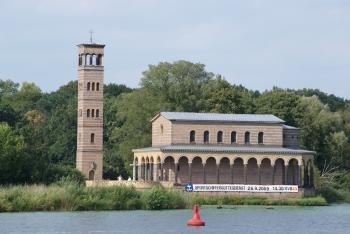
The Parks of Potsdam and Berlin extend over a large area and it is hardly possible to visit all sites at one day. There are six major parks: Sanssouci, New Garden, Babelsberg, Glienicke, Pfaueninsel and Sacrow. In each of the parks there are numerous palaces and small structures, built between the mid 18th and early 20th Century. Certainly, the main sight is the Park Sanssouci. In 1745, King Frederick II commissioned his architect Von Knobelsdorff to build a summer palace in the rococo style, in Potsdam, just outside Berlin. Sanssouci should be the intellectual centre of his empire and his refuge from the military and austere capital of Berlin. Frederick II was not only a statesman and military leader, he was also interested in art, science and philosophy. Voltaire spent two years as a guest in Sanssouci, and here was also the meeting of Frederick II with Johann Sebastian Bach. The composition "The Musical Offering" based upon a theme by Frederick II. His descendants built new parks and palaces around the lakes in Potsdam.
We visited Potsdam in the summer of 2009 and spent two and a half days there. The first day we went to the Park Sanssouci. The view of the palace with the wine terraces and the fountain is magnificent. It is always very crowded, but we were early enough to avoid the queues at the entrance. The audio guide tour through the interior took about 45 minutes. It was interesting to see the historic rooms, but I have to admit, it was not stunning. I liked much more the visit of the Charlottenhof Palace, the summer palace of Frederick William IV. It is a small palace in the style of a Roman villa. The interior is rather simple, but each room is designed differently. For example, there is a tent room that looks like the tent of a Roman Emperor. Other interesting buildings are the Orangery Palace, the Roman Baths and the Chinese House. Unfortunately, we could not visit the huge New Palace, built for festivities and guests of the royal court, it was closed. It is probably the only sight in Western Europe, which is closed on Tuesdays instead on Mondays. A good choice for the lunch break: at the Bornstedt Crown Estate is a brewery (Buffalo Beer!) with a beer garden.
On the second day we started at the Russian colony Alexandrowka with its beautiful log houses and an Orthodox chapel. We walked to the Belvedere on the Pfingstberg, from where you have a magnificent view over the lake landscape. Then, we visited the Cecilienhof Palace. It was built at the beginning of the 20th Century in the style of an English country house. Cecilienhof is known as the site of the Potsdam Conference in 1945, which marked in some way the end of WWII. Anyone who is interested in the recent history should visit Cecilienhof. The interior is almost unchanged and the audio guide provides a lot of information about the conference and its participants. Nearby is a symbol of the Cold War, the Glienicke Bridge, at the former border between West Berlin and East Germany. The US and the USSR used the bridge several times to exchange captured spies (at the movies and in reality). At the Glienicke Bridge we took a boat. This is certainly the most comfortable way to see the other parks. The round trip went past the Glienicke Palace, the Pfaueninsel, the Church of the Redeemer (striking because of its location and architecture, photo), and the Babelsberg Palace. You can get on and off at any stop.
The next morning, before we continued our journey, we made a detour to the Babelsberg Observatory. Mainly because I wanted to see an iconic building of modern architecture, the Einstein Tower by Erich Mendelssohn. It is not explicitly mentioned in the nomination document, but belongs to the observatory, so I think it also belongs to the WHS. Unfortunately you can not visit the interior. [comment in 2018: I was wrong here. The Einstein Tower is an observatory on the Telegrafenberg in Potsdam, operated by the Leibniz Institute for Astrophysics, it is not part of the WHS. The Babelsberg Observatory is located in the Babelsberg Park and within the core zone.]
For the evening, I recommend the pubs and cafés in the Dutch Quarter, that consists of many red brick houses in the Dutch style. All in all there is a lot to explore and it's worth to spend a day or two in the Parks of Potsdam and Berlin.
Comments
No comments yet.
